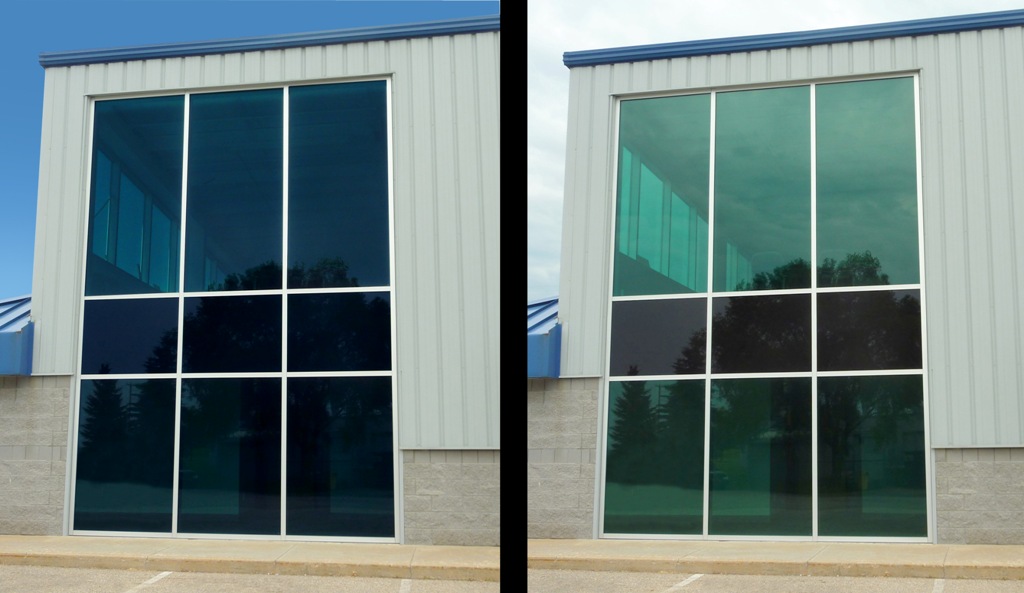PPG Industries and Pleotint, LLC, have agreed to jointly market a commercial window glass system that combines Sunlight Responsive Thermochromic, or SRT, interlayer technology by Pleotint, with Solarban low-emissivity (low-e) glass and other glasses by PPG to control solar heat gain and reduce energy costs in buildings.
Pleotint’s patented technology is a lightly tinted thermochromic interlayer that warms up and darkens in direct sunlight, but clears in indirect sunlight to allow light to pass into a building. Laminated between two lites of glass, SRT interlayer may be used monolithically or within an insulating glass unit. Visible light transmittance for windows with SRT interlayer adjusts through the day without the need for wiring, power supplies or controls.
When the SRT interlayer is combined in a window system with Solarban glass, a proven solar control, low-e glass that also blocks solar heat and transmits visible light, these adaptive windows can dramatically reduce the amount of energy required to cool buildings. Because the windows clear up in indirect sunlight, they also decrease the need for artificial lighting.
A study showed that, due to its ability to dynamically adjust to natural lighting conditions, a window system including an SRT interlayer can reduce energy costs in commercial buildings by 17 to 30% over industry-standard window systems. A window with SRT technology also reduces the transmittance of ultraviolet light and short-wavelength visible light, which are major contributors to fading in carpets, fabrics, artwork, photos and other materials.
Unlike competing dynamic windows that require manual, electrical or mechanical controls, windows with the SRT interlayer use the sun’s own energy – up to 1,000 watts of power per square meter – to adjust the window tint and transmittance level. Because the process is entirely self-sustaining, the SRT interlayer system not only uses less energy, it also eliminates the opportunities for failure due to faulty wiring, poor connections or broken electrical circuits. Windows with SRT interlayers also have passed exposure and durability testing developed for electrochromic windows and conducted by the National Renewable Energy Laboratory (NREL).
Insulating units with SRT interlayers and Solarban low-e glass are available in sizes up to 5 feet wide and have been laminated in lengths of up to 11 feet. Architects may specify any Oceans of Color tinted glass or Earth and Sky high-performance tinted glass by PPG as a base-state window color. BD+C
Related Stories
| Aug 11, 2010
RMJM unveils design details for $1B green development in Turkey
International architecture company RMJM today announced details of the $1 billion Varyap Meridian development it is designing in Istanbul’s new residential and business district, which will be one of the "greenest" projects in Turkey. The luxury 372,000-square-meter development on a site totalling 107,000 square meters will be located in the Atasehir district of Istanbul, which the Turkish government intends to transform into the country’s new financial district and business center.
| Aug 11, 2010
Urban Land Institute honors five 'outstanding' developments in Europe, Middle East, and Africa
Five outstanding developments have been selected as winners of the Urban Land Institute (ULI) 2009 Awards for Excellence: Europe, Middle East, and Africa (EMEA) competition. This year, the competition also included the announcement of two special award winners. The Awards for Excellence competition is widely regarded as the land use industry’s most prestigious recognition program.
| Aug 11, 2010
Design firms slash IT spending in 2009
Over half of architecture, engineering, and environmental consulting firms (55%) are budgeting less for information technology in 2009 than they did in 2008, according to a new report from ZweigWhite. The 2009 Information Technology Survey reports that firms' 2009 IT budgets are a median of 3.3% of net service revenue, down from 3.6% in 2008. Firms planning to decrease spending are expected to do so by a median of 20%.
| Aug 11, 2010
A glimmer of hope amid grim news as construction employment falls in most states, metro areas
The construction employment picture brightened slightly with 18 states adding construction jobs from April to May according to a new analysis of data released today by the Bureau of Labor Statistics (BLS). However, construction employment overall continued to decline, noted Ken Simonson, the chief economist for the Associated General Contractors of America.
| Aug 11, 2010
Thom Mayne unveils 'floating cube' design for the Perot Museum of Nature and Science in Dallas
Calling it a “living educational tool featuring architecture inspired by nature and science,” Pritzker Prize Laureate Thom Mayne and leaders from the Museum of Nature & Science unveiled the schematic designs and building model for the Perot Museum of Nature & Science at Victory Park. Groundbreaking on the approximately $185 million project will be held later this fall, and the Museum is expected to open by early 2013.
| Aug 11, 2010
SOM's William F. Baker awarded Fritz Leonhardt Prize for achievement in structural engineering
In recognition of his engineering accomplishments, which include many of the tallest skyscrapers of our time, William F. Baker received the coveted Fritz Leonhardt Prize in Stuttgart, Germany. He is the first American to receive the prize.
| Aug 11, 2010
American Concrete Institute forms technical committee on BIM for concrete structures
The American Concrete Institute (ACI) announces the formation of a new technical committee on Building Information Modeling (BIM) of Concrete Structures.
| Aug 11, 2010
10 tips for mitigating influenza in buildings
Adopting simple, common-sense measures and proper maintenance protocols can help mitigate the spread of influenza in buildings. In addition, there are system upgrades that can be performed to further mitigate risks. Trane Commercial Systems offers 10 tips to consider during the cold and flu season.







